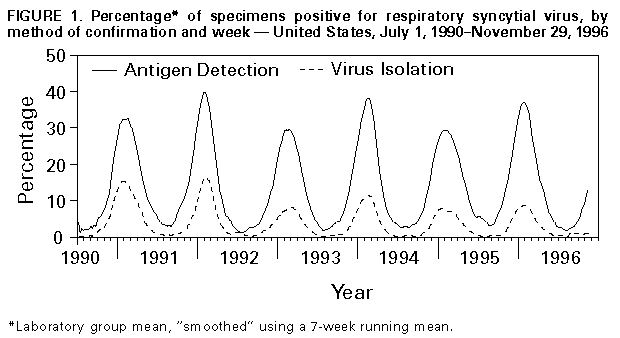 |

Update: Respiratory Syncytial Virus Activity -- United States,
1996-97 Season
Respiratory syncytial virus (RSV), a common cause of winter
outbreaks of acute respiratory disease, results in an estimated
90,000 hospitalizations and 4500 deaths each year from lower
respiratory tract disease in both infants and young children in the
United States (1). Outbreaks occur annually throughout the country
(2). RSV activity in the United States is monitored by the National
Respiratory and Enteric Virus Surveillance System (NREVSS), a
voluntary, laboratory-based system. This report summarizes trends
in RSV from the NREVSS from July 1, 1990, through June 28, 1996,
and presents provisional surveillance results for June 29-November
29, 1996. These data indicate onset of widespread RSV activity for
the 1996-97 season.
Since July 1, 1990, a total of 98 hospital-based and public
health laboratories in 47 states have participated in the NREVSS
and have reported weekly to CDC the number of specimens tested for
RSV by the antigen-detection and virus-isolation methods and the
number of positive results. Widespread RSV activity is defined by
the NREVSS as the first of two consecutive weeks during which at
least half of the participating laboratories report any RSV
detections. This definition generally indicates a mean percentage
of specimens positive by antigen detection in excess of 10%.
During the previous six seasons, from July 1990 through June
1996, onset of widespread RSV activity began in November and
continued for a mean of 22 weeks until April (Figure_1). In
most
parts of the 48 contiguous states, activity peaked each year in
January or February; however, in the Southeast, activity peaked as
early as November or December (3). For the reporting period June
29-November 29, 1996, a total of 75 laboratories in 45 states
reported results of testing for RSV. Since the week ending November
22, more than half of the participating laboratories reported
detections of RSV on a weekly basis, indicating onset of widespread
RSV activity for the 1996-97 season.
Reported by: National Respiratory and Enteric Virus Surveillance
System collaborating laboratories. Respiratory and Enterovirus Br,
Div of Viral and Rickettsial Diseases, National Center for
Infectious Diseases, CDC. Editorial Note
Editorial Note: During the RSV season, health-care providers should
consider the role of RSV as a cause of acute respiratory disease in
both children and adults. Most severe manifestations of infection
with RSV (e.g., pneumonia and bronchiolitis) occur in infants aged
2-6 months; however, children of any age with underlying cardiac or
pulmonary disease or who are immunocompromised are at risk for
serious complications from this infection. Because natural
infection with RSV provides limited protective immunity, RSV causes
repeated symptomatic infections throughout life. In adults, RSV
usually causes upper respiratory tract manifestations but may cause
lower respiratory tract disease -- especially in the elderly and in
immunocompromised persons (4-6). Infection in immunocompromised
persons can be associated with high death rates (6).
RSV is a common, but preventable, cause of nosocomially
acquired infection; the risk for nosocomial transmission increases
during community outbreaks. Sources for nosocomially acquired
infection include infected patients, staff, visitors, or
contaminated fomites. Nosocomial outbreaks or transmission of RSV
can be controlled with strict attention to contact-isolation
procedures (7). In addition, chemotherapy with ribavirin may be
considered for some patients (e.g., those at high risk for severe
complications or who are seriously ill with this infection) (8);
respiratory syncytial virus immune globulin intravenous (human) for
high-risk patients was licensed for use in January 1996 (9).
Vaccines for RSV are being developed, but none have been
demonstrated to be safe and efficacious (10).
References
Institute of Medicine. Appendix N: prospects for immunizing
against respiratory syncytial virus. In: Institute of Medicine.
New
vaccine development: establishing priorities. Vol 1: diseases
of
importance in the United States. Washington, DC: National
Academy
Press, 1985:397-409.
Gilchrist S, Torok TJ, Gary HE Jr, Alexander JP, Anderson LJ.
National surveillance for respiratory syncytial virus, United
States, 1985-1990. J Infect Dis 1994;170:986-90.
Torok TJ, Clarke MJ, Holman RC, Anderson LJ. Temporal and
spatial trends in respiratory syncytial virus activity in the
United States, 1990-1996 {Abstract}. In: RSV after 40 years: an
anniversary symposium (Charleston, South Carolina, November
9-12,
1996).
Dowell SF, Anderson LJ, Gary HE Jr, et al. Respiratory
syncytial
virus is an important cause of community-acquired lower
respiratory
infection among hospitalized adults. J Infect Dis
1996;174:456-62.
Falsey AR, Cunningham CK, Barker WH, et al. Respiratory
syncytial virus and influenza A infections in the hospitalized
elderly. J Infect Dis 1995;172:389-94.
Whimbey E, Couch RB, Englund JA, et al. Respiratory syncytial
virus pneumonia in hospitalized adult patients with leukemia.
Clin
Infect Dis 1995;21:376-9.
CDC. Guideline for prevention of nosocomial pneumonia. Respir
Care 1994;39:1191-236.
Committee on Infectious Diseases, American Academy of
Pediatrics. Reassessment of the indications for ribavirin
therapy
in respiratory syncytial virus infections. Pediatrics 1996;97:
137-40.
Groothuis JR, Simoes EA, Levin MJ, et al. Prophylactic
administration of respiratory syncytial virus immune globulin
to
high-risk infants and young children. N Engl J Med
1993;329:1524-30.
Murphy BR, Hall SL, Kulkarni AB, et al. An update on approaches
to the development of respiratory syncytial virus (RSV) and
parainfluenza virus type 3 (PIV3) vaccines. Virus Res
1994;32:13-36.
Figure_1

Return to top.
Figure_1

Return to top.
Disclaimer
All MMWR HTML versions of articles are electronic conversions from ASCII text into HTML. This conversion may have resulted in character translation or format errors in the HTML version. Users should not rely on this HTML document, but are referred to the electronic PDF version and/or the original MMWR paper copy for the official text, figures, and tables. An original paper copy of this issue can be obtained from the Superintendent of Documents, U.S. Government Printing Office (GPO), Washington, DC 20402-9371; telephone: (202) 512-1800. Contact GPO for current prices. **Questions or messages regarding errors in formatting should be addressed to mmwrq@cdc.gov.Page converted: 09/19/98
|
 |

